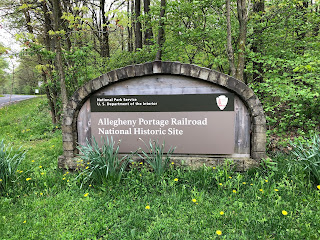Our son Richard teaches STEM (science, technology, engineering and math) classes at a middle school in southeast Washington, D.C. He often gives his students a collection of materials and tells them to build something that will solve the problem he poses. I thought of his students when Tim and I visited the NPS historic site for the Allegheny Portage Railroad. It is, in my opinion, a great example of thinking outside the box.
 |
| An incline house |
As workers on both canals approached the Alleghenies in March 1831, the state legislature authorized a bold plan in which canal boats filled with passengers and goods would be moved to rail cars and towed up a series of five inclines by a pulley system powered not by mules but by stationary steam engines in each incline house. On the descent, the boats would be let down five more grades, then transferred again to the canal.
 |
| A toy model at the Allegheny Portage Railroad National Historic Site |
But for a time, the Allegheny Portage Railroad was a grand and exciting idea.
When Charles Dickens toured the United States, he rode the Allegheny Portage Railroad and described his trip in his 1842 publication, American Notes for General Circulation, using these words:
"Occasionally, the rails are laid upon the extreme verge of a giddy precipice; and looking from the carriage window, the traveler gazes sheer down, without a stone or scrap of fence between, into the mountain depths below. The journey is very carefully made, however; only two carriages traveling together; and while proper precautions are taken, is not to be dreaded for its dangers..."Oh, my! This ride sounds just as thrilling as any of today's amusement park roller coasters. A grand and exciting ride, indeed!




Very interesting!
ReplyDeleteAnother historical gem. Unique part of our history that few have every heard about until you brought it to light. Wire rope! Even operating only for 23 years it is still an example of American ingenuity. Great post!
ReplyDeleteHey, Randy! I read that you and Pam are trying to figure out the next phase of life. Wishing you much wisdom as you make key decisions!
Delete